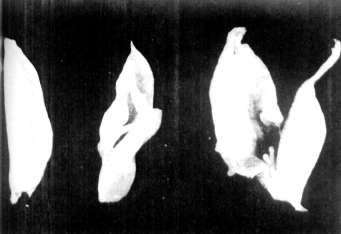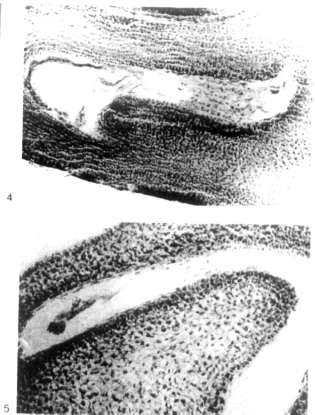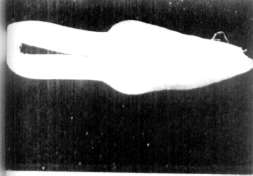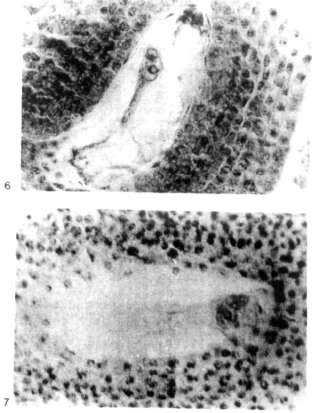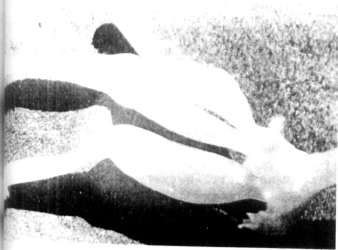TRANSFORMATIONS
OF MALE REPRODUCTIVE ORGANS INTO FEMALE ORGANS AND FEMALE STERILITY IN COCHLEATA MUTANTS OF
PISUM SATIVUM
Molchova, E., M. Vassileva, and
M. Micailova
Institute of Genetics, Sofia,
Bulgaria
Nine
cochleata mutants were induced in the varieties 'Ronal', 'Virtus', and 'Auralia'. All cochleata mutants,
although induced in different genotypes with different mutagens (gamma
rays, 5 and 10 krad; fast neutrons - 750 rads at 23.5 rad/min; and DS
-0.2%) show approximately the same "classical" phenotype of cochleata,
including malformed flowers, partial sterility and, most diagnostic of all, the
complete absence of stipules on the first 4 or 5 nodes. The plants also
are thinner, somewhat shorter, and have more branches than their initial
line (IL). Many of the flowers are smaller and open (Fig. 1). Seed
production is strongly reduced. The generative organs of the mutants show
different degrees of modification, including stamen pistilloidy.
The androceium may be transformed into a gynoecium with a stigma and
pappus. Stamens may expand laterally but remain flat and show different degrees of
development. Depending on the degree of transformation, the number of
stamens may decrease and the whole flower become filled with ovaries (Fig.
2,3).
Cytoembryological
studies reveal different abnormalities in the development of the embryosacs and ovules. The
pistils of transformed flowers become elongated but most often the embryo
sac degenerates (Fig. 4-7).
Ovule
development typically is arrested, but some ovules develop two to five nuclear embryosacs with a tendency
towards polarization of the nuclei in the lacuna of the sac, but with
changes in the vacuolization of the cytoplasm and picnozation and
aglutization of the nuclei result in lysis. Occasionally, the otherwise sterile
mutants have normally developed embryosacs with a normal sexual
apparatus. But in the transformed stamens not one case of normal seed
formation has been observed.
Studies of
the meiosis in PMC and the development of the male gameto-phyte revealed
disturbances which lead to sterility of the pollen, ranging from 25-100%.
The flower
anomalies described above were of the same type in all the cochleata mutants obtained from the three
varieties, Auralia, Ronal, and Virtus.
xxxxxxxxxxxxxxxxxxxxxxxxxxxxxxxxxxxxx
Editor's Note: Interested readers should
also consult Gottschalk,
W., 1971.
Fortschr. Evol. Forchung 6. Fischer. Stuttgart. 296
pp., and Gottschalk, W. 1973. PNL
5:8-9. xxxxxxxxxxxxxxxxxxxxxxxxxxxxxxxxxxxxx
